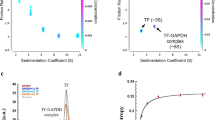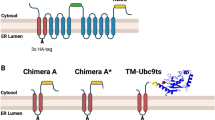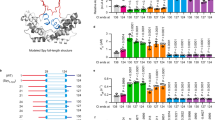Abstract
The ring-forming AAA+ chaperone ClpB cooperates with the DnaK chaperone system to reactivate aggregated proteins. With the assistance of DnaK, ClpB extracts unfolded polypeptides from aggregates via substrate threading through its central channel. Here we analyze the processing of mixed aggregates consisting of protein fusions of misfolded and native domains. ClpB–DnaK reactivated all aggregated fusion proteins with similar efficiency, without unfolding native domains, demonstrating that partial threading of the misfolded moiety is sufficient to solubilize aggregates. Reactivation by ClpB–DnaK occurred even when two stably folded domains flanked the aggregated moiety, indicating threading of internal substrate segments. In contrast with the related AAA+ chaperone ClpC, ClpB lacks a robust unfolding activity, enabling it to sense the conformational state of substrates. ClpB rings are highly unstable, which may facilitate dissociation from trapped substrates during threading.
This is a preview of subscription content, access via your institution
Access options
Subscribe to this journal
Receive 12 print issues and online access
$189.00 per year
only $15.75 per issue
Buy this article
- Purchase on Springer Link
- Instant access to full article PDF
Prices may be subject to local taxes which are calculated during checkout







Similar content being viewed by others
References
Wickner, S., Maurizi, M.R. & Gottesman, S. Posttranslational quality control: folding, refolding, and degrading proteins. Science 286, 1888–1893 (1999).
Hanson, P.I. & Whiteheart, S.W. AAA+ proteins: have engine, will work. Nat. Rev. Mol. Cell Biol. 6, 519–529 (2005).
Baker, T.A. & Sauer, R.T. ATP-dependent proteases of bacteria: recognition logic and operating principles. Trends Biochem. Sci. 31, 647–653 (2006).
Maurizi, M.R. & Xia, D. Protein binding and disruption by Clp/Hsp100 chaperones. Structure 12, 175–183 (2004).
Squires, C.L., Pedersen, S., Ross, B.M. & Squires, C. ClpB is the Escherichia coli heat shock protein F84.1. J. Bacteriol. 173, 4254–4262 (1991).
Goloubinoff, P., Mogk, A., Peres Ben Zvi, A., Tomoyasu, T. & Bukau, B. Sequential mechanism of solubilization and refolding of stable protein aggregates by a bichaperone network. Proc. Natl. Acad. Sci. USA 96, 13732–13737 (1999).
Zolkiewski, M. ClpB cooperates with DnaK, DnaJ, and GrpE in suppressing protein aggregation. A novel multi-chaperone system from Escherichia coli. J. Biol. Chem. 274, 28083–28086 (1999).
Motohashi, K., Watanabe, Y., Yohda, M. & Yoshida, M. Heat-inactivated proteins are rescued by the DnaK.J-GrpE set and ClpB chaperones. Proc. Natl. Acad. Sci. USA 96, 7184–7189 (1999).
Sanchez, Y. & Lindquist, S.L. HSP104 required for induced thermotolerance. Science 248, 1112–1115 (1990).
Queitsch, C., Hong, S.W., Vierling, E. & Lindquist, S. Heat shock protein 101 plays a crucial role in thermotolerance in Arabidopsis. Plant Cell 12, 479–492 (2000).
Hong, S.W. & Vierling, E. Mutants of Arabidopsis thaliana defective in the acquisition of tolerance to high temperature stress. Proc. Natl. Acad. Sci. USA 97, 4392–4397 (2000).
Siddiqui, S.M., Sauer, R.T. & Baker, T.A. Role of the processing pore of the ClpX AAA+ ATPase in the recognition and engagement of specific protein substrates. Genes Dev. 18, 369–374 (2004).
Weibezahn, J. et al. Thermotolerance requires refolding of aggregated proteins by substrate translocation through the central pore of ClpB. Cell 119, 653–665 (2004).
Lum, R., Tkach, J.M., Vierling, E. & Glover, J.R. Evidence for an unfolding/threading mechanism for protein disaggregation by Saccharomyces cerevisiae Hsp104. J. Biol. Chem. 279, 29139–29146 (2004).
Yamada-Inagawa, T., Okuno, T., Karata, K., Yamanaka, K. & Ogura, T. Conserved pore residues in the AAA protease FtsH are important for proteolysis and its coupling to ATP hydrolysis. J. Biol. Chem. 278, 50182–50187 (2003).
Hinnerwisch, J., Fenton, W.A., Furtak, K.J., Farr, G.W. & Horwich, A.L. Loops in the central channel of ClpA chaperone mediate protein binding, unfolding, and translocation. Cell 121, 1029–1041 (2005).
Dougan, D.A., Reid, B.G., Horwich, A.L. & Bukau, B. ClpS, a substrate modulator of the ClpAP machine. Mol. Cell 9, 673–683 (2002).
Andersson, F.I. et al. Cyanobacterial ClpC/HSP100 protein displays intrinsic chaperone activity. J. Biol. Chem. 281, 5468–5475 (2006).
Eriksson, M.J. & Clarke, A.K. The heat shock protein ClpB mediates the development of thermotolerance in the cyanobacterium Synechococcus sp. strain PCC 7942. J. Bacteriol. 178, 4839–4846 (1996).
Mogk, A. et al. Identification of thermolabile E. coli proteins: prevention and reversion of aggregation by DnaK and ClpB. EMBO J. 18, 6934–6949 (1999).
Tomoyasu, T., Mogk, A., Langen, H., Goloubinoff, P. & Bukau, B. Genetic dissection of the roles of chaperones and proteases in protein folding and degradation in the Escherichia coli cytosol. Mol. Microbiol. 40, 397–413 (2001).
Martin, A. & Schmid, F.X. Evolutionary stabilization of the gene-3-protein of phage fd reveals the principles that govern the thermodynamic stability of two-domain proteins. J. Mol. Biol. 328, 863–875 (2003).
Tsalkova, T.N. & Privalov, P.L. Thermodynamic study of domain organization in troponin C and calmodulin. J. Mol. Biol. 181, 533–544 (1985).
Wenk, M. & Jaenicke, R. Calorimetric analysis of the Ca2+-binding βγ-crystallin homolog protein S from Myxococcus xanthus: intrinsic stability and mutual stabilization of domains. J. Mol. Biol. 293, 117–124 (1999).
Gast, K. et al. Cold denaturation of yeast phosphoglycerate kinase: which domain is more stable? FEBS Lett. 358, 247–250 (1995).
Matouschek, A. Protein unfolding—an important process in vivo? Curr. Opin. Struct. Biol. 13, 98–109 (2003).
Weber-Ban, E.U., Reid, B.G., Miranker, A.D. & Horwich, A.L. Global unfolding of a substrate protein by the Hsp100 chaperone ClpA. Nature 401, 90–93 (1999).
Lee, S. et al. The structure of ClpB. A molecular chaperone that rescues proteins from an aggregated state. Cell 115, 229–240 (2003).
Lee, S., Choi, J.M. & Tsai, F.T. Visualizing the ATPase cycle in a protein disaggregating machine: structural basis for substrate binding by ClpB. Mol. Cell 25, 261–271 (2007).
Johnston, J.A., Johnson, E.S., Waller, P.R. & Varshavsky, A. Methotrexate inhibits proteolysis of dihydrofolate reductase by the N-end rule pathway. J. Biol. Chem. 270, 8172–8178 (1995).
Lee, C., Schwartz, M.P., Prakash, S., Iwakura, M. & Matouschek, A. ATP-dependent proteases degrade their substrates by processively unraveling them from the degradation signal. Mol. Cell 7, 627–637 (2001).
Ainavarapu, S.R., Li, L., Badilla, C.L. & Fernandez, J.M. Ligand binding modulates the mechanical stability of dihydrofolate reductase. Biophys. J. 89, 3337–3344 (2005).
Weibezahn, J., Schlieker, C., Bukau, B. & Mogk, A. Characterization of a trap mutant of the AAA+ chaperone ClpB. J. Biol. Chem. 278, 32608–32617 (2003).
Turgay, K., Hamoen, L.W., Venema, G. & Dubnau, D. Biochemical characterization of a molecular switch involving the heat shock protein ClpC, which controls the activity of ComK, the competence transcription factor of Bacillus subtilis. Genes Dev. 11, 119–128 (1997).
Turgay, K., Hahn, J., Burghoorn, J. & Dubnau, D. Competence in Bacillus subtilis is controlled by regulated proteolysis of a transcription factor. EMBO J. 17, 6730–6738 (1998).
Schlothauer, T., Mogk, A., Dougan, D.A., Bukau, B. & Turgay, K. MecA, an adaptor protein necessary for ClpC chaperone activity. Proc. Natl. Acad. Sci. USA 100, 2306–2311 (2003).
Wendler, P. et al. Atypical AAA+ subunit packing creates an expanded cavity for disaggregation by the protein-remodeling factor Hsp104. Cell 131, 1366–1377 (2007).
Hoskins, J.R., Yanagihara, K., Mizuuchi, K. & Wickner, S. ClpAP and ClpXP degrade proteins with tags located in the interior of the primary sequence. Proc. Natl. Acad. Sci. USA 99, 11037–11042 (2002).
Lee, C., Prakash, S. & Matouschek, A. Concurrent translocation of multiple polypeptide chains through the proteasomal degradation channel. J. Biol. Chem. 277, 34760–34765 (2002).
Burton, R.E., Siddiqui, S.M., Kim, Y.I., Baker, T.A. & Sauer, R.T. Effects of protein stability and structure on substrate processing by the ClpXP unfolding and degradation machine. EMBO J. 20, 3092–3100 (2001).
Piwko, W. & Jentsch, S. Proteasome-mediated protein processing by bidirectional degradation initiated from an internal site. Nat. Struct. Mol. Biol. 13, 691–697 (2006).
Hoppe, T. et al. Activation of a membrane-bound transcription factor by regulated ubiquitin/proteasome-dependent processing. Cell 102, 577–586 (2000).
Tian, L., Holmgren, R.A. & Matouschek, A. A conserved processing mechanism regulates the activity of transcription factors Cubitus interruptus and NF-κB. Nat. Struct. Mol. Biol. 12, 1045–1053 (2005).
Orian, A. et al. Structural motifs involved in ubiquitin-mediated processing of the NF-κB precursor p105: roles of the glycine-rich region and a downstream ubiquitination domain. Mol. Cell. Biol. 19, 3664–3673 (1999).
Singh, S.K., Guo, F. & Maurizi, M.R. ClpA and ClpP remain associated during multiple rounds of ATP-dependent protein degradation by ClpAP protease. Biochemistry 38, 14906–14915 (1999).
Kress, W., Mutschler, H. & Weber-Ban, E. Assembly pathway of an AAA+ protein: tracking ClpA and ClpAP complex formation in real time. Biochemistry 46, 6183–6193 (2007).
Zietkiewicz, S., Krzewska, J. & Liberek, K. Successive and synergistic action of the Hsp70 and Hsp100 chaperones in protein disaggregation. J. Biol. Chem. 279, 44376–44383 (2004).
Zietkiewicz, S., Lewandowska, A., Stocki, P. & Liberek, K. Hsp70 chaperone machine remodels protein aggregates at the initial step of Hsp70-Hsp100-dependent disaggregation. J. Biol. Chem. 281, 7022–7029 (2006).
Carrio, M.M. & Villaverde, A. Localization of chaperones DnaK and GroEL in bacterial inclusion bodies. J. Bacteriol. 187, 3599–3601 (2005).
Kirstein, J. et al. Adaptor protein controlled oligomerization activates the AAA+ protein ClpC. EMBO J. 25, 1481–1491 (2006).
Acknowledgements
We thank P. Tessarz for critical reading of the manuscript and E. Vierling (Department of Biochemistry and molecular biophysics, University of Arizona, USA) for providing 16.6 sHsp antibodies. This work was supported by grants from the Deutsche Forschungsgemeinschaft (Bu617/17-1) to B.B. and A.M., the Fond der Chemischen Industrie to B.B. and a Heisenberg Fellowship of the DFG to A.M.
Author information
Authors and Affiliations
Contributions
T.H., A.Z., A.M. and B.B conceived and designed experiments. T.H., A.Z. and I.B. performed experiments; T.H., A.Z., I.B., J.K., K.T., A.M. and B.B. analyzed the data; J.K. and K.T. assisted in experimental design; A.M. and B.B. wrote the manuscript.
Corresponding authors
Supplementary information
Supplementary Text and Figures
Supplementary Figures 1–7 and Supplementary Table 1 (PDF 3292 kb)
Rights and permissions
About this article
Cite this article
Haslberger, T., Zdanowicz, A., Brand, I. et al. Protein disaggregation by the AAA+ chaperone ClpB involves partial threading of looped polypeptide segments. Nat Struct Mol Biol 15, 641–650 (2008). https://doi.org/10.1038/nsmb.1425
Received:
Accepted:
Published:
Issue Date:
DOI: https://doi.org/10.1038/nsmb.1425
This article is cited by
-
Three J-proteins impact Hsp104-mediated variant-specific prion elimination: a new critical role for a low-complexity domain
Current Genetics (2020)
-
Stress-induced protein aggregates shape population heterogeneity in bacteria
Current Genetics (2019)
-
Cotranslational assembly of protein complexes in eukaryotes revealed by ribosome profiling
Nature (2018)
-
Dynamic structural states of ClpB involved in its disaggregation function
Nature Communications (2018)
-
Fusion protein analysis reveals the precise regulation between Hsp70 and Hsp100 during protein disaggregation
Scientific Reports (2017)



